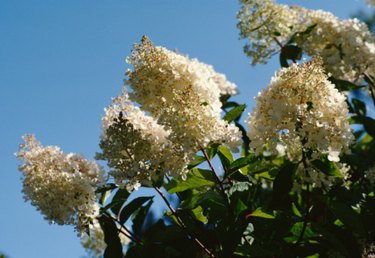
Crape myrtles are ornamental shrubs or trees. They are also deciduous, which means they lose their leaves in the winter. The crape myrtle is most often associated with its vibrant summer blooms, but when properly maintained, it is an attractive addition to the landscape during all seasons of the year.
Plant Description
Video of the Day
Crape myrtles are a low-maintenance and long-lived plant species. Once established, plants are also very drought-tolerant. Crape myrtles have relatively few problems with disease or pest infestations. The plant produces an abundance of flowers even in the absence of, or with very little, fertilizer. While plant height ranges from 3 feet to 35 feet, crape myrtles are most commonly maintained as small trees.
Video of the Day
Growing Conditions
Crape myrtles are grown in USDA hardiness zones 7 through 10. They are well-adapted for warm, humid climates, but will tolerate arid conditions if provided supplemental irrigation during prolonged dry periods. Crape myrtles require at least six hours of full sunlight per day to induce flowering and maintain fast, symmetrical growth. These plants prefer well-drained, slightly acidic, loamy soil with a pH between 5.0 and 6.5.
Flowers
Crape myrtles produce vibrant and long-lasting flower clusters on the tips of new growth. Each flower cluster, also called a panicle, is composed of hundreds of small flowers. Altogether, each panicle measures approximately 6 to 18 inches in length and 3 to 5 inches wide. Flower colors include shades of pink, purple, white, red and lavender. Individual flower petals possess a crinkled appearance like crape paper. Blooming time varies by cultivar, but generally begins in June, lasting through September.
Pruning
Crape myrtles do not require pruning in order to bloom. In fact, plants will produce flowers without any pruning whatsoever. In general, flower clusters on unpruned trees will be smaller but more numerous. On the other hand, correct, light pruning can improve plant shape and encourage the development of larger blooms. Avoid hard pruning, particularly the type of pruning called crape murder, which refers to the practice of pruning off the top of the plant without regard to its true form. This encourages excess vegetative growth, basal sprouting, reduced flowering and weakly attached new growth.